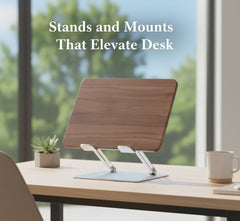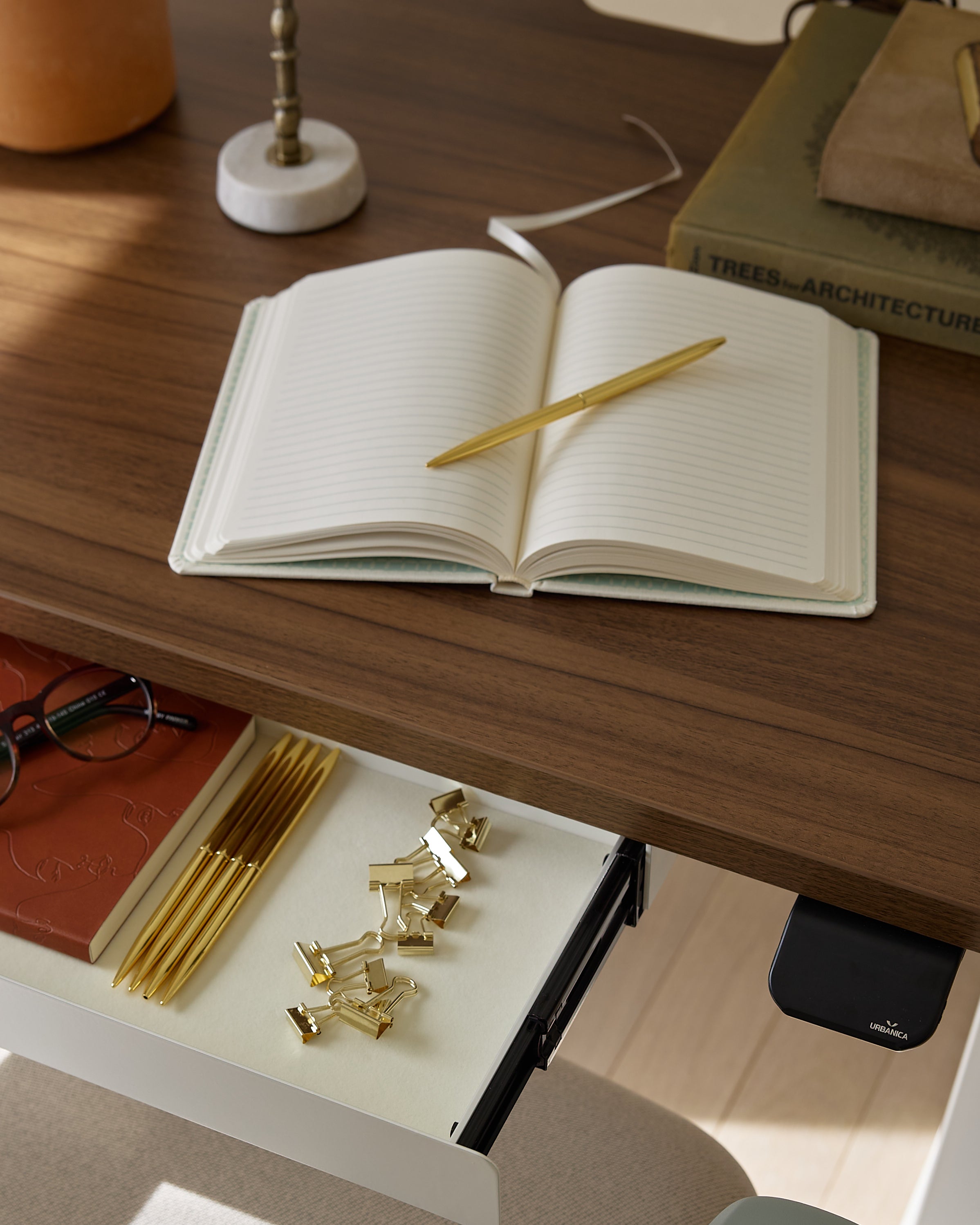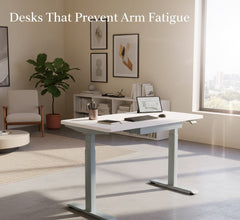Get 10% off your first order
Find the office furniture that’s designed to match your style, comfort, and needs perfectly. Subscribe
Stands and Mounts That Elevate Desk

Visit quiz page to see how we makes it easy to create an inspiring workplace


Remote and hybrid work have turned laptops into full-time production machines. Video conferencing, local development environments, browser-based creative tools, and cloud drives all converge on a single device that moves between rooms and offices. The desk that supports this workflow has to do more with less. It must offer reliable posture support, clean cable paths, and adequate space for peripherals without dominating the room. The goal is a surface and structure that enable focus while keeping movement fluid and unobstructed.
Professionals who log long hours on portable hardware share a common set of needs. They require fast transitions from typing to reading to presenting, stable surfaces that minimize wobble during high-speed typing, and unobtrusive storage for a few essentials. They also benefit from guidance that aligns workspace choices with sound health principles. The Centers for Disease Control and Prevention provides foundational advice on posture and workstation setup through its resource on ergonomic workspace design, which applies directly to long sessions on a laptop.
Low-profile design is not just about thin tops or minimalist silhouettes. It is a disciplined set of proportions that support reach, sight lines, and legroom. Depth typically falls within a corridor that keeps the screen at an appropriate distance without pushing the chair too far into the room. Height should pair well with task seating and, when adjustable, should move smoothly enough that the user does not interrupt concentration. The frame should resist racking forces and vibration so that keystrokes feel grounded rather than springy.
Large executive surfaces encourage clutter, increase the distance to power sources, and make it harder to place lighting correctly. Laptops benefit from a layout that focuses on the essentials: a clear central zone for the device, a zone for peripherals, and a back edge that accommodates stands or a compact monitor without pushing the keyboard into an uncomfortable reach.
Research in environmental psychology consistently points to the benefits of orderly surroundings. Clean lines reduce decision friction, and an absence of visual noise helps knowledge workers maintain mental energy over long stretches. The right desk is a quiet partner that keeps tools accessible while avoiding attention-grabbing details.
The structural geometry of a compact workstation determines how it feels hour after hour. Pay attention to depth, knee clearance, and the way the legs interact with seating and foot movement. Rounded front edges can reduce pressure on forearms. Stiffness in the long direction prevents wobble when the user types quickly or uses a precision pointing device.
| Design Element | Practical Target | Why It Matters |
|---|---|---|
| Surface Depth | Often 22 to 28 inches | Keeps the display at a comfortable viewing distance while preserving room flow |
| Surface Width | Sized to room constraints | Supports peripheral placement without forcing overreach |
| Legroom Height | Commonly 27 to 28.5 inches to underside | Allows neutral thigh position and free foot movement |
| Edge Profile | Softened radius or bevel | Reduces contact pressure on forearms and wrists |
| Frame Stiffness | Minimal lateral flex | Improves typing stability and reduces vibration fatigue |
| Cable Pass-Through | Back or corner grommets, under-surface channels | Keeps chargers and docks organized, reduces snag risk |
Engineered wood with high-quality lamination offers consistent flatness that benefits keyboard feel and accessory placement. Bamboo provides a warmer touch and a softer visual presence. Powder-coated steel frames deliver long-term rigidity in a compact footprint. Finishes should resist abrasion from trackpads and accessories, and edges should maintain their shape under daily use.
Laptops concentrate connectivity into a small area. Use a compact dock that mounts under the surface or sits at the back edge, then route cables through channels secured with reusable ties. A shallow tray or low-profile raceway near the rear can collect adapters and charger bricks without impinging on legroom. The goal is to make power available where needed while keeping the field of view uncluttered.
A laptop’s integrated keyboard and display invite hunching if the surface and chair are not set correctly. Elevating the screen to eye level with a stand or a compact external monitor helps, as does using an external keyboard and pointing device that match shoulder width and natural wrist angles. Feet should rest flat, hips and knees should approximate right angles, and the screen should be high enough to minimize neck flexion.
Regular position changes can reduce stiffness and improve comfort. When an adjustable model is appropriate, smooth and predictable motion reinforces the habit of alternating between sitting and standing. A dedicated example is the Standing Desk, which supports a consistent switch in working posture while preserving a clean silhouette suitable for compact spaces.
A separate keyboard placed at forearm height promotes neutral wrist alignment. An external pointing device should sit close to the keyboard’s edge to minimize reach. If a second display is used, center it or align it with the dominant task window to avoid repeated neck rotation. Headsets and microphones can hang from discreet hooks under the surface so cables do not drag across the work area.
Two users in a tight footprint need independent control of height and enough separation to avoid elbow conflict. A purpose-built configuration like the Two-Person Standing Office Desk demonstrates how a compact plan can still respect individual ergonomics while maintaining a clean, unified presence.
Low-profile furniture reads as calm when proportions, colors, and textures are consistent. Neutral surfaces, restrained hardware, and clean leg geometry maintain a balanced visual field that does not compete with the work. Good lighting and thoughtful placement of accessories keep the composition coherent and reduce eye strain.
Some rooms must serve as both a professional backdrop and a personal living area. A versatile option like the Office Desk delivers a measured form that suits either context. It aligns with the principle that productivity furniture should feel intentional rather than improvised.
Shallow drawers, discreet trays, and narrow shelves keep stationery and peripherals close without increasing mass. Vertical storage above or beside the desk creates capacity while preserving legroom. The goal is to give every object a home so that the surface can reset quickly at the end of a session.
A compact workstation gains impact when it is placed with purpose. Position the surface perpendicular to windows to catch natural light without glare, and measure reach to outlets to minimize cable runs. Consider how chairs roll relative to rugs, and leave room for standing transitions. If the space doubles as a studio or guest room, choose finishes that harmonize with the broader palette so the desk reads as part of the architecture rather than an add-on.
Soft surfaces near the workstation, such as curtains and small area rugs, can calm reverberation during calls. Task lighting with a focused beam produces contrast that keeps eyes energized without harshness. Calm acoustic and visual conditions protect concentration during deep work.
Long compile times, video rendering, and data analysis can heat portable hardware. Leave space at the rear and sides for exhaust, and avoid dense piles of paper or fabric near vents. Stands that angle the device upward can improve airflow and typing comfort simultaneously.
For studio apartments, compact bedrooms, or tight corners of a living space, a carefully sized surface can still host a complete workstation. A specific option that aligns with these constraints is the Mini Standing Desk. Its compact format suits spaces where every inch counts, and its height variability supports posture changes that help maintain energy during long sessions.
Even when the furniture is small, zoning helps. Keep a cable tray at the rear for power, reserve the center zone for the laptop or main keyboard, and allocate a side zone for a writing pad or tablet. This deliberate arrangement reduces mid-task searching and maintains a clean line of sight.
Use a pouch or slim caddy for chargers, adapters, and small drives. Stowing these items under the rear edge or in a shallow drawer preserves a quiet visual field yet keeps essentials close.
Compact principles also apply to multi-user spaces. The aim is to preserve clear sight lines and personal comfort while fitting more productive stations into a given footprint. Symmetry, cable routing, and consistent finishes help shared environments feel ordered rather than crowded.
A configuration intended for a small team should enable quick conversation and fast transitions between individual and group tasks. The Quad Workstation illustrates how four contributors can work in proximity while retaining personal space, defined cable paths, and a coherent visual language.
As headcount grows, the furniture system should scale without introducing visual noise. The Six-Person Workstation Desk shows how consistent proportions and shared routing can maintain clarity for a larger team. The result is an office that feels composed, with energy devoted to the work rather than to negotiating the environment.
When desks, storage, seating, and dividers share a design vocabulary, the space wears in a balanced way. Replacement parts and add-ons should integrate with the original system to maintain coherence. This protects the investment and makes incremental changes easier to absorb.
Selecting a workstation benefits from a clear, testable checklist. Match dimensions to room constraints, confirm stiffness and edge comfort, and ensure the finish suits the tasks at hand. Physically simulate reach to outlets and network drops, and map cable routes before installation.
1. Measure the room and define maximum depth that preserves walking lanes.
2. Sit at the position where the desk will live and verify sight lines to natural and task lighting.
3. Place a laptop and external keyboard on a placeholder surface to test posture and reach.
4. Confirm chair arm height and legroom relative to the frame.
5. Map power and data paths, then plan cable containment with ties and channels.
6. If adjustability is important, cycle height changes to get a feel for stability and control layout.
7. Inspect the finish for resistance to scratches from stands and peripherals.
8. Confirm that accessory storage will not intrude on knees or feet.
9. Review the vendor’s range to ensure consistency if expansion is likely.
10. Schedule a habit of movement intervals to support comfort over time.
When comparing options from a single vendor, it helps to view the family together to understand dimensions and finishes across models. A curated overview such as the Desk Collection makes it easier to align room constraints, aesthetic goals, and accessory plans.
Long-term comfort comes from small repeated habits and occasional adjustments. Wipe surfaces with nonabrasive cleaners to protect finishes. Re-tighten fasteners as part of periodic maintenance to preserve rigidity. Revisit cable routing when new equipment is added so that the path remains clear and safe.
Set a reminder to change position at intervals that suit your work, and use a timer or gentle haptic cue if needed. Rotate peripherals to reduce repetitive strain, such as switching the pointing device side for short periods, provided it does not interfere with productivity.
As lighting conditions change with the season, revisit the angle of the display and placement of task lamps. Small shifts can reduce glare and improve clarity without altering the furniture.
A productive workstation is a system rather than a surface. Define a central device zone, auxiliary input zone, reference material zone, and a staging area for devices that enter and leave the space. Keep only active tools within arm’s reach, and archive the rest so that context switching does not become scavenger hunting.
Input: external keyboard aligned with shoulder width and a pointing device placed close to the home row.
Vision: single centered display or a laptop stand that lifts the screen to eye level, with any secondary display grouped rather than scattered.
Power: dock or charger secured near the rear with slack managed by ties.
Audio: headset hook under the surface, microphone positioned to the side to keep the central zone clear.
Storage: a slim drawer or side shelf for pens, notepads, and adapters.
Ventilation keeps performance steady during long computational tasks. Keep intake and exhaust paths open, and use stands that increase underside clearance if needed. For data security in shared environments, use cable locks where appropriate and segment personal devices from communal power strips to reduce accidental unplugging.
Different professions produce different desk pressures. Developers may prioritize keyboard feel, wrist alignment, and screen clarity for code review. Designers and editors may require a consistent color environment and precise lighting control. Analysts who operate multiple datasets might value a supplemental display and rigorous cable management that protects connections during frequent equipment swaps.
A solo laptop setup can thrive on a narrow depth if the sight line is tuned carefully. A slim stand, external input devices, and a single task light form a complete system that fits in a small alcove or along a spare wall.
Users who carry both a personal and a work machine can rely on a compact dock and two vertical stands placed at the rear. Inputs switch through the dock so that devices remain stationary and cables stay organized.
Short sessions with a second person benefit from a surface that allows shoulder-to-shoulder review without collision. In this case, a slightly wider top or a small pull-out auxiliary tray can make collaboration smoother without changing the main footprint.
The path forward for compact desks is grounded in refinement rather than spectacle. Expect incremental improvements in surface materials that resist wear, quieter motion systems for adjustable models, and cleaner accessory integration that keeps cables out of sight while remaining serviceable. Thoughtful proportions will continue to matter most, because comfort, clarity, and freedom of movement are what sustain productive work in spaces of any size.

Stands and Mounts That Elevate Desk

Table Bases That Won’t Wobble Over Time

Desks That Prevent Arm Fatigue
Get 10% off your first order
Find the office furniture that’s designed to match your style, comfort, and needs perfectly. Subscribe
Leave a comment